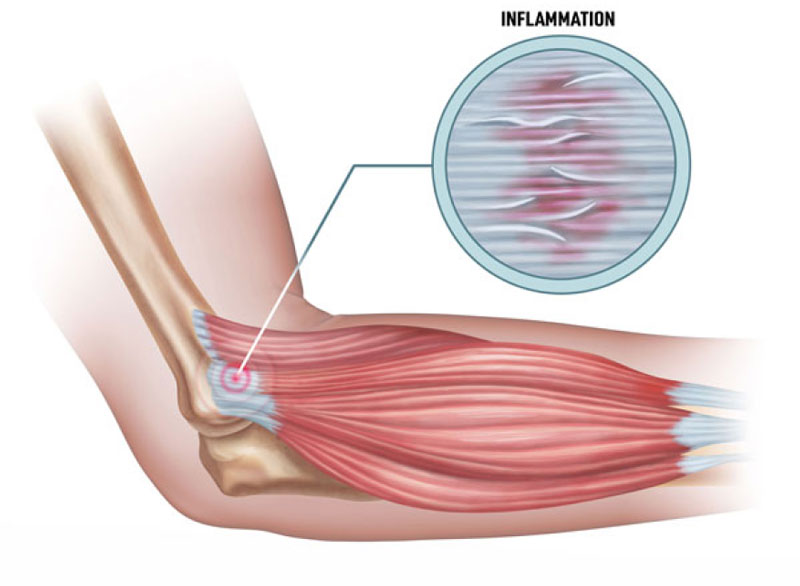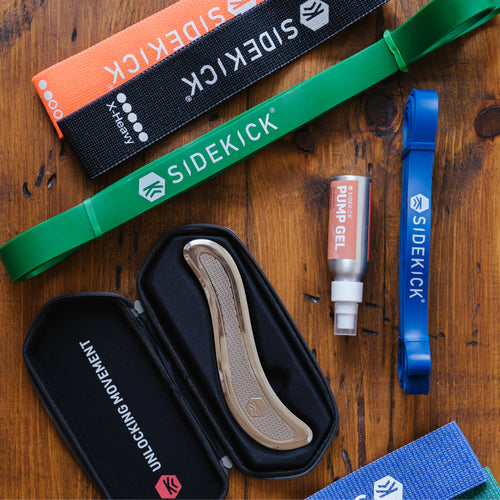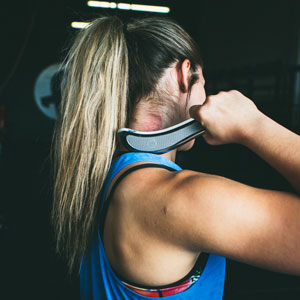Ever wonder what the benefits are of muscle scraping? We'll answer this question below. With so many recovery modalities out there, it’s natural to feel skeptical about muscle scraping.
Scraping therapy stimulates multiple mechanisms to decrease pain and promote recovery. Based on scientific research and clinical studies, this page will explain why you should be using muscle scraping as part of your recovery plan.
why use muscle scraping
2,000 years of history, backed by modern science
Scraping therapy is based off Gua Sha, a treatment that has been used for centuries in Traditional East Asian Medicine to treat both acute and chronic muscular pain. The physiological mechanisms have since been analyzed and proven effective [1] through comprehensive research around the world. This technique uses scraping of the skin to induce petechiae, bright red spots on the skin, which have been shown to have therapeutic effects on muscle pain and recovery.
Helps restore proper muscle function
Muscle scraping is an easy, non-invasive technique that helps promote the healing and recovery of stressed tissue. After a hard workout or a mild injury, many processes lead to stiffness and altered function within a muscle. In general, scraping therapy reverses these processes to help you quickly regain pain-free mobility.
Prevents and Heals Chronic Injuries
Chronic injuries often correspond with increased scar tissue deposition and adhesions, which reduce elasticity and cause dysfunction in the injured tissue. The pressure and shear force from the muscle scraping tool releases the adhesions and scar tissue that have built up over time [6].
In addition, hemorrhaging of the small vessels increases blood flow, nutrient supply, and fibroblast migration to the area [6]. Fibroblast cells play a role in depositing new collagen to facilitate the healing of wounded tissue [7] .
Not all muscle scraping tools are created equal. Sidekick’s scrapers have a refined scraping edge that promotes both of these processes. Learn more here.
In combination with stretching and strengthening, these processes allow new, healthy tissue to regenerate and realign to heal chronic injuries.
In addition, hemorrhaging of the small vessels increases blood flow, nutrient supply, and fibroblast migration to the area [6]. Fibroblast cells play a role in depositing new collagen to facilitate the healing of wounded tissue [7] .
Not all muscle scraping tools are created equal. Sidekick’s scrapers have a refined scraping edge that promotes both of these processes. Learn more here.
In combination with stretching and strengthening, these processes allow new, healthy tissue to regenerate and realign to heal chronic injuries.
Promotes pain suppression
Muscle scraping affects what’s called the spino-thalamic-cortical pathway [2] in the nervous system. When the muscle is manipulated by an outside source, this pathway sends a signal to activate the part of the brain that is responsible for inhibiting pain transmission. The breaking down of blood vessels achieved by scraping will activate this pathway, ultimately shutting off the pain signals and resulting in a significant decrease in pain.
In a clinical trial [3], patients with chronic neck pain received gua sha treatment to their entire neck and upper back. Results 7 days after treatment showed a 26% overall decrease in pain and a 51% decrease in pain related to movement.
In a clinical trial [3], patients with chronic neck pain received gua sha treatment to their entire neck and upper back. Results 7 days after treatment showed a 26% overall decrease in pain and a 51% decrease in pain related to movement.
Promotes recovery by increasing blood flow
When you are exercising, your muscles consume energy but leave behind toxic debris that can clog the blood vessels within your muscles. The body depends on blood flow to supply nutrients and remove toxic waste during recovery, which will be prevented if vasculature is clogged. Scraping breaks up these blocked vessels and signals the body to reconstruct new, more efficient ones. The breaking of these old blood vessels is what causes petechiae, and is proven to increase blood flow [4], allowing the recovery process to resume. Learn more about this process here.
promotes anti-Inflammatory effects

Inflammation can cause fatigue, discomfort, and overall impairment to the function of your muscles. One study [5] performed on labratory mice showed that the release of a chemical in the body, called heme oxygenase-1 (HO-1) [5], (known to prevent processes that lead to inflammation) increases significantly after scraping. Levels of the enzyme were measured before and after the mice received gua sha using an imaging procedure and the overall result was a deep, systemic anti-inflammatory effect.
Inflammatory vs Anti-Inflammatory
Is muscle scraping inflammatory or anti-inflammatory? The answer is: both! Scraping often produces redness and swelling on the surface due to the small blood vessels dilating to allow increased blood flow to the area. This inflammation causes the upregulation of HO-1 [5].
Therefore, the inflammatory response to scraping is localized, surface-level, and short-term. The anti-inflammatory effects occur within the organ systems throughout the body and last for several days thereafter.
Inflammatory vs Anti-Inflammatory
Is muscle scraping inflammatory or anti-inflammatory? The answer is: both! Scraping often produces redness and swelling on the surface due to the small blood vessels dilating to allow increased blood flow to the area. This inflammation causes the upregulation of HO-1 [5].
Therefore, the inflammatory response to scraping is localized, surface-level, and short-term. The anti-inflammatory effects occur within the organ systems throughout the body and last for several days thereafter.
Increases range of motion
After injury or stress to a muscle, it is common to have a build up of unneeded cells and scar tissue. This creates stiffness in the muscle which impairs function and mobility, decreasing the ability to move through a full range of motion. The increase in blood flow, which is promoted by scraping, speeds up the removal of this scar tissue and debris, thus restoring function and range of motion.
Conclusion: everyone can benefit from muscle scraping
While the technique of muscle scraping is largely unknown to the general population, Chinese ancestors have been using it for over 2,000 years, while Chiropractic and Physical Therapy practitioners have been applying it to patients for at least the last 3 decades.
Whether you've suffered from a minor accident, or have chronic muscle soreness from an active lifestyle, muscle scraping can help you. Read more to see what others have had to say about it.
If you're ready to get started, visit this page to find the right tool for you.
Whether you've suffered from a minor accident, or have chronic muscle soreness from an active lifestyle, muscle scraping can help you. Read more to see what others have had to say about it.
If you're ready to get started, visit this page to find the right tool for you.
Sources and References:
[1] Lauche R;Wübbeling K;Lüdtke R;Cramer H;Choi KE;Rampp T;Michalsen A;Langhorst J;Dobos GJ; (2012). Randomized controlled pilot study: Pain intensity and pressure pain thresholds in patients with neck and low back pain before and after traditional East Asian "Gua Sha" therapy. The American journal of Chinese medicine.
[2] Musial, F., Spohn, D., & Rolke, R. (2013, June 20). Naturopathic reflex therapies for the treatment of chronic back and neck pain - part 1: Neurobiological Foundations. Complementary Medicine Research.
[3] Braun, M., Schwickert, M., Nielsen, A., Brunnhuber, S., Dobos, G., Musial, F., Lüdtke, R., & Michalsen, A. (2011, March 25). Effectiveness of traditional Chinese "Gua Sha" therapy in patients with chronic neck pain: A randomized controlled trial. OUP Academic.
[4] Nielsen A;Knoblauch NT;Dobos GJ;Michalsen A;Kaptchuk TJ; (2007). The effect of Gua Sha treatment on the microcirculation of surface tissue: A pilot study in healthy subjects. Explore (New York, N.Y.).
[5] Kwong, K. K., Kloetzer, L., Wong, K. K., Ren, J.-Q., Kuo, B., Jiang, Y., Chen, Y. I., Chan, S.-T., Young, G. S., & Wong, S. T. C. (2009, August 28). Bioluminescence imaging of heme oxygenase-1 upregulation in the Gua Sha procedure. Journal of visualized experiments : JoVE.
[6] Kim, J., Sung, D. J., & Lee, J. (2017). Therapeutic effectiveness of instrument-assisted soft tissue mobilization for soft tissue injury: Mechanisms and practical application. Journal of Exercise Rehabilitation, 13(1), 12–22. https://doi.org/10.12965/jer.1732824.412
[7] Dick MK, Miao JH, Limaiem F. Histology, Fibroblast. [Updated 2022 May 8]. In: StatPearls [Internet]. Treasure Island (FL): StatPearls Publishing; 2022 Jan-. Available from: https://www.ncbi.nlm.nih.gov/books/NBK541065/









